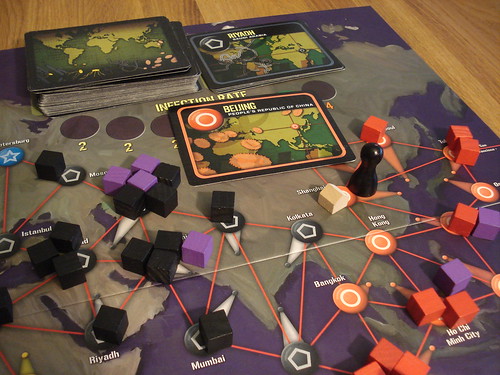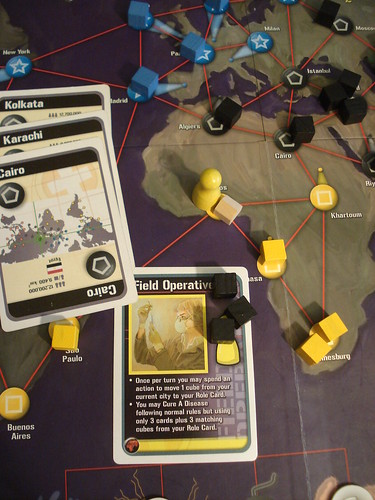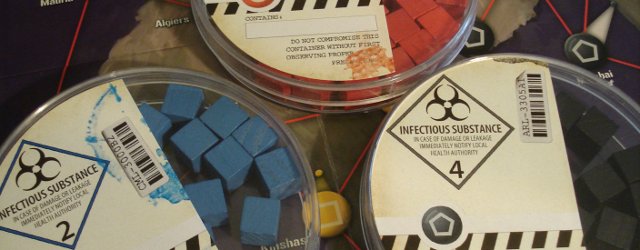| Strategy | Luck |
|---|---|
| Interaction | Components & Design |
| Complexity | Score |
If you click on the “Reviews” link up there, and then go all the way back to the first entry, you will find Pandemic. Pandemic is especially dear to me, not only because it was our first review, but because Meople’s Magazine grew around it. The Pandemic review was there first, and then we set up our design around it to make it look nice – not completely without success, even if I do say so myself.
So, why did it take us so relatively long to come up with a review for the first – and so far only – expansion On The Brink. Did we stop enjoying Pandemic? Not at all, Pandemic is still played regularly and the coop game we play most. The simple reason we didn’t review On The Brink earlier is that it was impossible to find an English edition around here, and having a German expansion for an English game is just weird.

On The Brink is not one expansion but rather a package of three independent expansions plus some extra goodies. Lets look at the extra goodies first: there is a bunch of new role cards, new special events and an additional Epidemic! card to play on Legendary difficulty. The new role cards are, amazingly enough, free of overlap with the original roles and each other, and all of them bring a valuable special ability to the game. To give some examples, the Generalist can take five actions on her turn instead of the usual four, the Field Operative can collect disease samples and use three samples and three cards to discover a cure and the Archivist can hold up to eight cards and take the card for her current location back from the player discard pile. With all the new role cards, it is now also possible to play Pandemic with five people – of course you could play with five before, but then you would always have all the original roles, which is boring, and besides the rules said you can’t.
The new event cards tend to be slightly more powerful than the ones in the base game, but they are still quite situational, you have to think about when and how to use them. The new events include, among others, “Borrowed Time” (the current player may take two additional actions), “Rapid Vaccine Deployment” (remove some disease cubes from the board as soon as a cure is found) and the very powerful “Commercial Travel Ban” that sets the infection rate to one for one full round – quite handy near the end of a Legendary game. The new event cards are not just shuffled into the player pile: before the game, you take out all special event cards, shuffle them, and put two back into the player pile for each player. We didn’t read that part on our first two games, and Pandemic can be slightly silly when one player has only event cards on his hand …

The real – organic guaranteed free of disease – meat of the expansion is in the three new game variants. If you’re unfamiliar with the Pandemic base game, now might be a good time to give the review a quick skim, because the next few paragraphs will make a lot more sense when you know the original rules.
Virulent Strain
Virulent Strain is the part with the least changes to the base game: you replace the original Epidemic! cards with the Virulent Strain ones. When the first Epidemic! happens, the disease with the most cubes on the board is determined to be the virulent strain. All Epidemic! cards have special instructions regarding this disease. You might require an additional card to find the cure, add a cube of that disease to all cities with exactly one, remove four cubes from the supply and other such fun activities.
You can adjust the difficulty of Virulent Strain using more or less Epidemic! cards, just as you would in the base game. Pandemic with Virulent Strain is always a bit tougher than the standard game – one disease is receiving a boost, after all. Just how much tougher it is depends on the Epidemic! cards that you end up with, when they come and which characters you have. Anyway, Legendary Virulent Strain promises to offer a nice challenge. It’s a fun variant, and a good place to start into the expansion since no one has to learn any new rules. Virulent Strain can be combined with either of the other two variants if they’re still not challenging enough for you.
Mutation
Mutation adds a fifth disease to the game that behaves differently from the others. To play with the Mutation variant, you shuffle the three Mutation Event cards into the player draw pile and put the two Mutation cards with the discarded Infection cards – that way, they will come up soon after the first Epidemic!
The Mutation Cards make you draw a card from the bottom of the Infection pile and infect that city with a purple Mutation cube, of the Mutation Event cards two have a similar effect – only that you add three cubes to one city or one cube to three cities – the third one adds one purple cube to every city with exactly two. Once a city is infected with a purple cube, drawing that city’s Infection card adds one cube of the usual colour plus one purple one – this is not good news in any way, because the supply of purple cubes is limited to 12, instead of the 24 for other diseases, and running out still makes you lose the game. Consequently, you really really do not want an outbreak of the mutated disease.
To find the cure for the mutated purple pox, you need to discard 5 city cards of any combination of colours at a Research Centre, as long as one of the cities discarded is currently infected with the purple disease. The purple vaccine, however, is not strictly necessary to win the game. You can win by having all fives vaccines researched, but you can also win by researching the usual four and removing all purple cubes from the board.Mutation is – at least in my experience so far – harder than both the base game and the Virulent Strain variant. You have to work to keep the purple cube supply from running out, have to take more actions to cure two diseases in one city, and if you decide to research the vaccine for the purple pox, you have to manage your cards more tightly because that is five cards you’re not using to travel or research the four other vaccines. The question whether you should research the fifth vaccine is by no means trivial, either: on the one hand, you are using more cards to do it, on the other hand, not running out of cubes becomes a lot easier after the vaccine is developed.
The Bio-Terrorist
This is the most transformative of the three options, it cross-breeds the original Pandemic with the 1983 classic Scotland Yard and leaves us to deal with their antisocial offspring. For all but one player, playing the game is not so different: they still travel the world, cure sick people and hope to develop the vaccines to end diseases once and for all. The last player, however, is there to derail their plans, plunge the world into chaos and, ultimately, kill all humans. This variant has one player playing against everyone else. It is, however, not a coop game with traitor because it’s known from the beginning who the bad guy is.

The Bio-Terrorist does not usually place their meeple on the board, instead they take hidden notes when they took what action. The only time they become visible on the board is when another player is in the same city with them. He also doesn’t play with the player cards: the Bio-Terrorist uses Infection cards for his moves. The Terrorists goal is to spread his purple disease cubes over the world, it’s his fictional lilanthrax. Once these cubes are on the board, they behave like they do in the Mutation variant when their city is drawn from the infection pile. The one difference is that an outbreak of lilanthrax only leaves one purple cube in the city, making it slightly harder for the Terrorist to get all his cubes on the board.
So what can the Terrorist do? Many things, and he can do them fast. The Bio-Terrorist takes a turn after every good guy’s turn, so he can move around very quickly and wreak havoc all over the world. The Terrorist gets three actions for his turn. One of them can only be a Drive action: follow one of the red lines. The other two actions can be:
- Drive: same as before, just follow a red line.
- Direct Flight / Charter Flight: just like the other players, the Terrorist can move to or from a city by discarding the corresponding card – or course that’s the Infection card in his case
- Draw a card: the Terrorist does not automatically draw card, he has to spend one action per card
- Pass: just what it says on the tin.
- Infect Locally: place a purple disease cube at the terrorists current location. (Since the Terrorist also uses the purple cubes, this variant can not be combined with Mutation).
- Infect Remotely: play a card to put a purple cube in that city, no matter where the Terrorist himself is
- Sabotage: blow up a research centre in your current location. You need to play a card of the right color for that city, but not the card for exactly that city.
The last three actions can only be taken while not spotted by another player, and not multiple times per turn. Still, this Terrorist is an incredibly dangerous person and will surely be shot on sight, right? Not quite, I’m afraid: another player in the same city as the Terrorist can spend an action to capture him. In most cases, this is more a waste of time than anything else, since a captured Terrorist still has two actions he can take: draw cards and escape via direct flight. The Terrorist is not carrying any liquids with him, so boarding a plane is completely legal for him, even when under arrest … I could turn this into a rant about pointless airport security. Oh wait, I believe I just did.

With a bad guy to oppose, victory conditions for the Bio-Terrorist variant obviously have to change a little. The heroes can win in two ways: research all five vaccines, or research the four original vaccines and remove all of the Terrorists purple cubes. They lose by all the normal conditions and also by running out of purple cubes. The villain, on the other hand, wins when the heroes lose and there is at least one purple cube on the board.
Playing the Terrorist is a fun change of pace: there is different ways to victory, evading the other players is fun – even if they cannot do much to you – and playing with the Infection cards is an interesting twist: without cards, the Terrorist is severely limited in his options, but on the other hand, he will be reluctant to draw cards after an Epidemic!. After all, an Infection card held by the terrorist is not going to come up in the other player’s Infection phase and will not gain new cubes of any colour without the Terrorist interfering.
Playing against the terrorist, however, quickly turns from fun to desperation. The Terrorist has all the advantages. He moves faster, he doesn’t have to worry about the other diseases and time is working for him. Even an ineffective Terrorist has great chances to win the game by simply running the others out of cards: finding the purple vaccine costs cards, travelling to remote locations the terrorist is spreading his disease costs cards and having to rebuild a research stations that mysteriously exploded costs cards, while also making travelling more expensive because you cannot use research centres for free travel when they go up in flames. Since the Terrorist wins when there is at least one purple cube on the board when everyone else loses, just keeping everyone too busy to complete the game is a safe way to win the game. We tried to play with two, three and four players against the Terrorist, and although the manual advises against the last variant it was the closest to victory the good guys got – they still lost the game. It seems the only way to win against the terrorist is to research the purple vaccine as early as possible and then make a concentrated effort to remove all purple cubes from the board. This strategy has two possible outcomes: either it fails and just wasted a lot of cards without defeating the terrorist, or it succeeds and eliminates the terrorist from the game early on. Player elimination in an originally cooperative game is not something anyone asked for, and the fact that only one player can be eliminated makes it worse – he’s not going to start a new game before everyone else is finished. At least he can supply the other players with purple-disease-laced coffee while they keep playing. In addition to the balancing and elimination issues, playing with the Terrorist also adds a big chunk to the playing time.
So, out of the three new variants, two are fun while only changing the game slightly while the third changes it more and makes it unbalanced – is On The Brink an expansion you will really want to have. Well, it depends. When you played the original Pandemic enough that you can consistently win on Heroic difficulty but still enjoy it, On The Brink has many ways to shake up your game: the new roles alone can force you to reconsider your strategy, the Legendary difficulty is very challenging and the Virulent Strain and Mutation both offer fun new variations on Pandemic and even the Terrorist challenge is entertaining, if unbalanced. On top of that you get a set of utterly useless but awesomely fitting plastic Petri dishes to store your diseases in. So if you loved the original Pandemic, then you will see On The Brink as a worthy investment, but if your feelings about the game are more subdued, don’t expect On The Brink to magically make you like it.













Oooh a bad guy variant! The game kinda lacked that so far. How does the coopertive/taling and planning bit work with the terrorist present at the table?
The manual says you’re not supposed to leave the table for your coop talk, the terrorist is allowed to hear everything.
But since the terrorist has a turn after every player, he can react to everything the other players do, anyway, so it’s not a huge (additional) advantage for him.
My handwriting is not bad, it is just ~*unique*~.